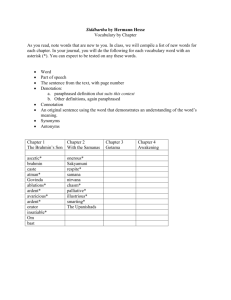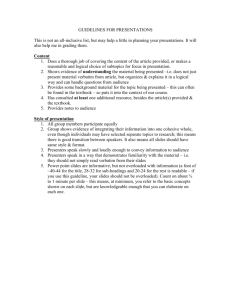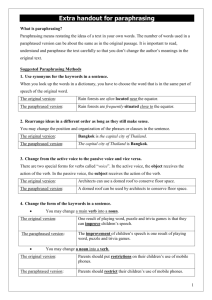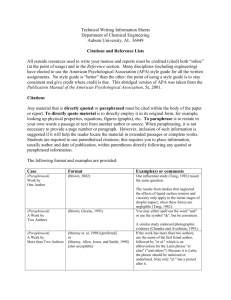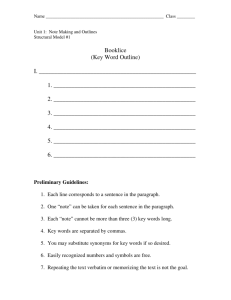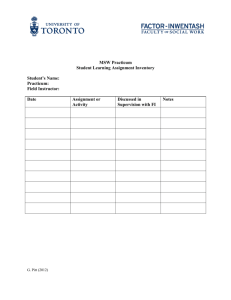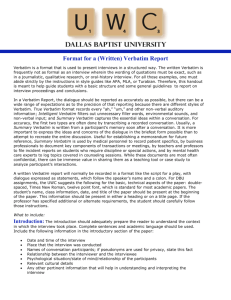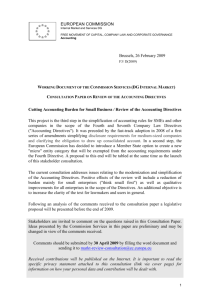1 - prestera fx
advertisement
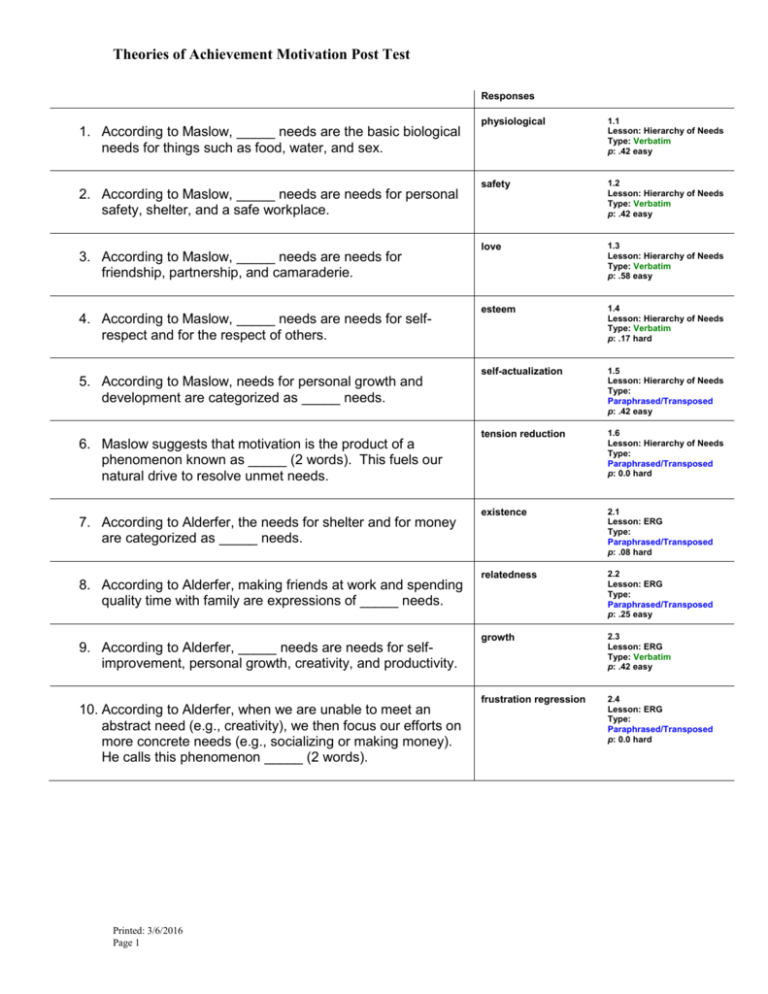
Theories of Achievement Motivation Post Test Responses 1. According to Maslow, _____ needs are the basic biological needs for things such as food, water, and sex. 2. According to Maslow, _____ needs are needs for personal safety, shelter, and a safe workplace. 3. According to Maslow, _____ needs are needs for friendship, partnership, and camaraderie. 4. According to Maslow, _____ needs are needs for selfrespect and for the respect of others. 5. According to Maslow, needs for personal growth and development are categorized as _____ needs. 6. Maslow suggests that motivation is the product of a phenomenon known as _____ (2 words). This fuels our natural drive to resolve unmet needs. 7. According to Alderfer, the needs for shelter and for money are categorized as _____ needs. 8. According to Alderfer, making friends at work and spending quality time with family are expressions of _____ needs. 9. According to Alderfer, _____ needs are needs for selfimprovement, personal growth, creativity, and productivity. 10. According to Alderfer, when we are unable to meet an abstract need (e.g., creativity), we then focus our efforts on more concrete needs (e.g., socializing or making money). He calls this phenomenon _____ (2 words). Printed: 3/6/2016 Page 1 physiological 1.1 Lesson: Hierarchy of Needs Type: Verbatim p: .42 easy safety 1.2 Lesson: Hierarchy of Needs Type: Verbatim p: .42 easy love 1.3 Lesson: Hierarchy of Needs Type: Verbatim p: .58 easy esteem 1.4 Lesson: Hierarchy of Needs Type: Verbatim p: .17 hard self-actualization 1.5 Lesson: Hierarchy of Needs Type: Paraphrased/Transposed p: .42 easy tension reduction 1.6 Lesson: Hierarchy of Needs Type: Paraphrased/Transposed p: 0.0 hard existence 2.1 Lesson: ERG Type: Paraphrased/Transposed p: .08 hard relatedness 2.2 Lesson: ERG Type: Paraphrased/Transposed p: .25 easy growth 2.3 Lesson: ERG Type: Verbatim p: .42 easy frustration regression 2.4 Lesson: ERG Type: Paraphrased/Transposed p: 0.0 hard Theories of Achievement Motivation Post Test 11. According to Herzberg, _____ factors are tangible outcomes and things that focus on a worker’s physical wellbeing. 12. According to Herzberg, _____ factors are intangible outcomes such as recognition, responsibility, respect, and interest in the job. 13. The program developed by Herzberg that involves redesigning jobs and stresses the importance of motivating outcomes is called _____ (acronym is acceptable). 14. According to Skinner, _____ (2 words) is a form of reward that involves giving something that is liked or wanted as a consequence of some behavior. 15. According to Skinner, _____ (2 words) is a form of reward that involves removing something that is disliked as a consequence of some behavior. 16. According to Skinner, _____ is the removal of something a person likes or the addition of something a person dislikes. 17. A commission-only sales person who is rewarded after each sale of a product is an example of someone who is on a(an) _____ schedule (2 words). 18. A contractor who is paid only upon completion of work related to a project is an example of someone who is on a(an) _____ schedule. 19. An office worker who is paid the same amount every two weeks is an example of someone who is on a(an) _____ schedule. Printed: 3/6/2016 Page 2 Extrinsic hygiene Intrinsic motivator orthodox job enrichment oje 3.1 Lesson: Two-Factor Type: Verbatim p: .75 easy 3.2 Lesson: Two-Factor Type: Verbatim p: .58 easy 3.3 Lesson: Two-Factor Type: Paraphrased/Transposed p: .25 easy positive reinforcement 4.1 Lesson: Reinforcement Type: Verbatim p: 1.00 easy negative reinforcement 4.2 Lesson: Reinforcement Type: Verbatim p: .83 easy punishment 4.3 Lesson: Reinforcement Type: Verbatim p: .58 easy continuous reinforcement 4.4 Lesson: Reinforcement Type: Paraphrased/Transposed p: .25 easy ratio 4.5 Lesson: Reinforcement Type: Paraphrased/Transposed p: .58 easy interval 4.6 Lesson: Reinforcement Type: Paraphrased/Transposed p: .75 Theories of Achievement Motivation Post Test 20. According to Vroom, _____ is the amount of motivation a person has to engage in a particular behavior. 21. According to Vroom, _____ is the confidence an individual feels that he/she can perform the behavior successfully. 22. According to Vroom, it is important that a person feel that performing a task will lead to particular reward. He called this feeling _____. 23. Each of us assigns different values to possible rewards or outcomes. Vroom refers to this value as a person's _____. 24. According to Bandura, the confidence you feel in your ability to perform well on this test refers to your _____. 25. According to Bandura, the _____ (2 words) means that those who have high self-efficacy, try harder and more often succeed, while those who have low self-efficacy put forth less effort and therefore usually fail. 26. According to Bandura, _____ is the ability to overcome obstacles in the pursuit of a goal. 27. Conducting focus groups to gather employee input on important organizational decisions is an example of _____ decision-making. 28. _____ is a program that allows workers to design their own work schedule. 29. According to Adams, the tangible and intangible things that you put into your job are called _____. Printed: 3/6/2016 Page 3 force 5.1 Lesson: Expectancy Type: Verbatim p: .25 hard expectancy 5.2 Lesson: Expectancy Type: Verbatim p: 0.0 hard instrumentality 5.3 Lesson: Expectancy Type: Paraphrased/Transposed p: 0.0 hard valance 5.4 Lesson: Expectancy Type: Paraphrased/Transposed p: .25 (Midpoint - REMOVE) self-efficacy 6.1 Lesson: Empowerment Type: Paraphrased/Transposed p: .25 galatea effect 6.2 Lesson: Empowerment Type: Verbatim p: .17 hard commitment 6.3 Lesson: Empowerment Type: Verbatim p: 0.0 hard participatory 6.4 Lesson: Empowerment Type: Paraphrased/Transposed p: 0.0 hard flextime 6.5 Lesson: Empowerment Type: Verbatim p: .25 hard inputs 7.1 Lesson: Equity Type: Paraphrased/Transposed p: .33 Theories of Achievement Motivation Post Test 30. According to Adams, the tangible and intangible things that you get out of your job are called _____. 31. When you take the total value of what you put into your job and divide it by the total value of what you get out of your job, you come up with a(an) _____ (2 words). 32. According to Adams, the feelings of resentment or guilt that arise from comparing our situations with those of others are called _____ (2 words). 33. According to Locke and Latham, the extent to which a goal statement details the criteria for success is called goal _____. 34. According to Locke and Latham, goal _____ is the degree to which a worker considers a goal challenging. 35. According to Locke and Latham, goals will continue to be motivating only if people are provided frequent ______ (2 words). 36. According to Locke and Latham, goal _____ is the degree to which individual workers accept their goals. 37. _____ are the knowledge, skills, and attitudes (KSAs) that comprise a worker’s capacity to accomplish a goal. 38. _____ (acronym is acceptable) is a popular management approach in which workers and their supervisors collaborate with each other to set individual goals that align with higher-level organizational goals. 39. Maslow proposed a model with five categories of needs. This model comes from _____ Theory. 40. Alderfer proposed a model consisting of three categories of needs. This is a product of _____ Theory. Printed: 3/6/2016 Page 4 outputs 7.2 Lesson: Equity Type: Paraphrased/Transposed p: .42 easy equity ratio 7.3 Lesson: Equity Type: Paraphrased/Transposed p: 0.0 hard inequity tension 7.4 Lesson: Equity Type: Paraphrased/Transposed p: .0.0 hard specificity 8.1 Lesson: Goal Setting Type: Paraphrased/Transposed p: .17 hard difficulty 8.2 Lesson: Goal Setting Type: Verbatim p: .33 (Midpoint – REMOVE) performance feedback 8.3 Lesson: Goal Setting Type: Paraphrased/Transposed p: .08 hard commitment 8.4 Lesson: Goal Setting Type: Verbatim p: 0.0 competencies 8.5 Lesson: Goal Setting Type: Verbatim p: 0.0 management-byobjectives 8.6 Lesson: Goal Setting Type: Verbatim p: .25 hard mbo hierarchy of needs 9.1 Lesson: N/A Type: Principle p: .08 hard erg 9.2 Lesson: N/A Type: Principle p: .08 hard Theories of Achievement Motivation Post Test 41. The distinction between intrinsic and extrinsic factors is most closely associated with _____ Theory. 42. The use of rewards and punishments is most consistent with _____ Theory. 43. The use of a mathematical formula to predict motivation levels is most consistent with _____ Theory. 44. Promoting the importance of self-efficacy is the main contribution of _____ Theory. 45. Worker perceptions of inputs and outputs are most closely associated with _____ Theory. 46. Management by objectives is an approach that is most closely associated with _____ Theory. Printed: 3/6/2016 Page 5 two-factor 9.3 Lesson: N/A Type: Principle p: .08 hard reinforcement 9.4 Lesson: N/A Type: Principle p: .17 (??) expectancy 9.5 Lesson: N/A Type: Principle p: .25 easy empowerment 9.6 Lesson: N/A Type: Principle p: .33 easy equity 9.7 Lesson: N/A Type: Principle p: .17 easy goal-setting 9.8 Lesson: N/A Type: Principle p: .17 easy Theories of Achievement Motivation Post Test Printed: 3/6/2016 Page 6
